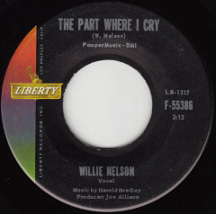"The Part Where I Cry" is a song written by country music singer Willie Nelson. After moving to Nashville in 1960, leveraged by the success of his songwriting, and helped by Harlan Howard, Nelson was signed by Joe Allison of Liberty Records.
| "The Part Where I Cry" | ||||
|---|---|---|---|---|
 | ||||
| Single by Willie Nelson | ||||
| B-side | "Mr. Record Man" | |||
| Released | November 1961 | |||
| Recorded | August 22, 1961 | |||
| Studio | Bradley Studios, Nashville, Tennessee | |||
| Genre | Country | |||
| Length | 2:12 | |||
| Label | Liberty | |||
| Songwriter(s) | Willie Nelson | |||
| Producer(s) | Joe Allison | |||
| Willie Nelson singles chronology | ||||
| ||||
In August 1961, his first session with the label was held at Bradley Studios, where he recorded the song. It was later coupled with "Mr. Record Man" on the B-side. While it failed to chart, the single received airplay.
Background
editDuring his time in Houston, Nelson sold his original "Family Bible", that turned into a hit for Claude Gray. Despite that he was not credited as the songwriter on the record, he took advantage of the recognition that the song granted him, and moved to Nashville in 1960.[1] While he joined Ray Price's band as a bass player, his songs became hits for other artists, including "Funny How Time Slips Away" (Billy Walker), "Pretty Paper" (Roy Orbison), and, most famously, "Crazy" by Patsy Cline.[2]
Leveraged by his prominence as a songwriter in Nashville, Tennessee, and after his friend Harlan Howard forwarded his songs to producer Joe Allison, Nelson was signed to Liberty Records in 1961.[3]
Recording and release
editNelson entered his first session for Liberty on August 22, 1961, at Bradley Studios in Nashville, Tennessee. Nelson was backed by guitarists Kelso Herston, Ray Edenton (who also played fiddle), Harold Bradley and Grady Martin; drummer Buddy Harman, pianist Hargus "Pig" Robbins, bassist Joe Zinkan and the Anita Kerr singers.[4] During the night, until the early hours of the following day Nelson recorded "The Part Where I Cry", to be the first single release with the label.[5] Allison was not pleased with the results of the session.[4]
The single was coupled with the B-side "Mr. Record Man", recorded during a September session in California.[5] Released in November 1961, Billboard's review predicted a "moderate sales potential".[6] Despite it failed to chart,[7] the song received good airplay on radio stations.[8] It was later included on Nelson's debut album ...And Then I Wrote.[5]
Footnotes
edit- ^ Patoski, Joe Nick 2008, p. 102.
- ^ Erlewine, Michael 1997, p. 324.
- ^ Patoski, Joe Nick 2008, p. 126.
- ^ a b Patoski, Joe Nick 2008, p. 127.
- ^ a b c Thomson, Graeme 2012, p. 73.
- ^ Billboard staff 1961, p. 36.
- ^ Scobey, Lola 1982, p. 111.
- ^ Bush, Johnny 2007, p. 85.
References
edit- Billboard staff (1961). "Reviews of New Singles". Billboard. Vol. 73, no. 43. Nielsen Business Media, Inc. ISSN 0006-2510.
- Bush, Johnny (2007). Whiskey River (Take My Mind): The True Story of Texas Honky-Tonk. University of Texas Press. ISBN 978-0-292-71490-8.
- Erlewine, Michael (1997). All Music Guide to Country: The Experts' Guide to the Best Recordings in Country Music. Miller Freeman. ISBN 978-0-87930-475-1.
- Patoski, Joe Nick (2008). Willie Nelson: An Epic Life. Hachette Digital. ISBN 978-0-316-01778-7.
- Scobey, Lola (1982). Willie Nelson: Country Outlaw. Kensington Pub Corp. ISBN 978-0-89083-936-2.
- Thomson, Graeme (2012). Willie Nelson: The Outlaw. Random House. ISBN 978-1-448-13341-3.